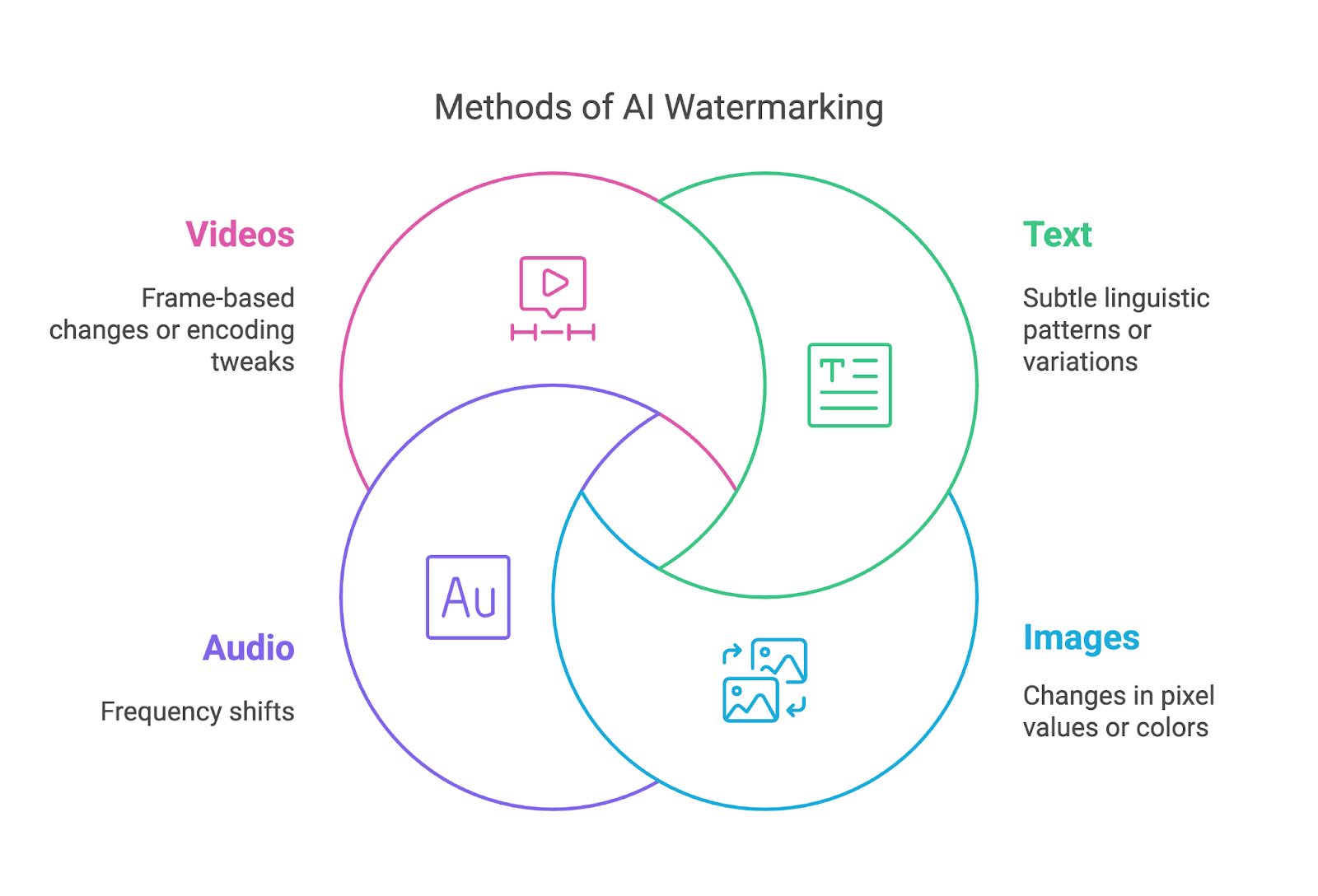Track
From lifelike videos and audio recordings to photorealistic images and engaging articles, AI-generated content is becoming more and more pervasive. While it can be used for good, it also opens the door to serious misuse, such as spreading misinformation, manipulating public opinion, and misleading voters during elections.
As such, verifying the provenance and authenticity of the digital content has never been more important. Doing so allows us to mitigate the potential harms of generative models. This is where AI watermarking comes into play, offering a critical tool in labeling and detecting AI-generated content, which is essential in combating its misuse.
In this blog post, I’ll explain what AI watermarking is and how it works, highlight its key applications, and explore the challenges and limitations it faces.
What Is AI Watermarking?
AI watermarking is a technique that embeds recognizable signals (i.e., the watermark) into AI-generated content in ways that make the content traceable and protected without compromising its quality.

AI watermarks can be embedded in various ways depending on the content type:
- Text: Subtle linguistic patterns or variations.
- Images: Changes in pixel values or colors.
- Audio: Frequency shifts.
- Videos: Frame-based changes or specific encoding tweaks.
Watermarks can be classified based on two main factors:
- Visibility
- Imperceptible watermarks: These are not directly noticeable to humans and can only be identified algorithmically, such as slight changes in the structure of text.
- Visible watermarks: These are overt and easily recognizable, such as a logo or text overlay on an image or video.
- Resilience to manipulation:
- Robust watermarks: These can withstand content alterations like compression, cropping, scaling, and editing.
- Fragile watermarks: These are easily destroyed by any modification but are still useful for verifying the integrity of the original, unmodified content.
How AI Watermarking Works?
Let me walk you through how AI watermarking works. At its core, AI watermarking involves two main stages: embedding (or encoding) and detection.
The embedding or the encoding process can be achieved in various ways including adding noise patterns and modifying low-order bits.
The detection process can be done by using algorithms that look for specific patterns or statistical anomalies in the generated content or even by training a machine learning model to distinguish watermarked content from non-watermarked content.
The whole watermarking process can be implemented in three main ways:
- During the generative process itself (generative watermarking).
- By editing already generated media (edit-based watermarking).
- By altering the generative model’s training data (data-driven watermarking).
Each of these methods has its own unique strengths, and the choice of technique depends on the type of content and the use case.
Applications of AI Watermarking
Now, let’s focus on the key applications of AI watermarking. In the next sections, I’ll focus on intellectual property protection and provenance tracking, authenticity verification, and responsible AI use.
Intellectual property protection and provenance tracking
While reading the paper “Watermarking Makes Language Models Radioactive,” I was fascinated by its exploration of how AI watermarking can protect the intellectual property of large language models.
The study introduces the concept of “radioactivity,” showing how watermarked texts leave detectable traces used to fine-tune another model. This approach provides a way for generative AI model developers to trace authorized reuse of their AI-generated content, ensuring accountability for the use of their intellectual property.
Authenticity verification
Beyond its importance in protecting the intellectual property of generative AI models, AI watermarking also serves a key role in verifying authenticity and exposing deepfakes or manipulated content.
For me, this dual capability is what makes it such an indispensable technology. By embedding subtle, traceable markers into AI-generated content, watermarking allows us to detect manipulation and maintain trust in an online world increasingly filled with misinformation.
Responsible AI use
Following the importance of AI watermarking in authenticity verification, I also see watermarking as an important step in encouraging responsible AI use. It makes it easier to identify AI-generated content, keeping generative AI developers and users accountable. Generative AI creators will be more mindful of how they use AI tools, ensuring that they don’t mislead audiences or engage in unethical practices.
AI Ethics
For anyone looking to understand the broader challenges of AI Watermarking—particularly issues related to governance, control, and the use of detection outcomes—the “What Lies Ahead for Generative AI Watermarking” paper is a must-read.
Challenges and Limitations of AI Watermarking
While AI watermarking holds immense promise, there are still challenges and limitations to consider. In the following sections, I’ll explore key issues, including the trade-off between robustness and imperceptibility of watermarks, the impact of transformations on detection accuracy, and the need for industry standards.
Robustness
Increasing robustness usually involves embedding a watermark more strongly into the content, making it more resilient to attacks and harder to remove. However, this often comes at the cost of imperceptibility, as a stronger watermark can become more noticeable to users, affecting the content’s visual or auditory quality.
On the flip side, making the watermark less perceptible often involves embedding it more subtly into the content. However, subtle watermarks are usually more vulnerable to attacks like compression or cropping.
Detection accuracy
Another key challenge to consider is how the detection accuracy of AI Watermarking techniques can be affected by factors such as compression, resizing and cropping.
Take compression, for example. Compression algorithms are designed to reduce file size by removing redundant or less important data, and unfortunately, subtle watermarks often fall into the category of “removable” data, leaving the AI-generated content undetectable.
Cropping takes this challenge one step further—if the watermark is located in a part of the content that is cropped out, there is no chance of detecting it in the remaining image.
Standardization
AI watermarking still faces challenges, particularly the lack of industry-wide standards, which makes interoperability difficult and slows down broader adoption. However, I find the recent developments encouraging.
For instance, Google DeepMind’s SynthID has introduced a production-ready watermarking scheme for text that maintains high detection accuracy with minimal latency.
I also find Meta’s work on video watermarking fascinating. They have in fact recently published Video Seal, a comprehensive framework that inserts signals into videos to ensure their robustness against transformations (i.e., compression).

Overview of digital video watermarking. Source: Meta AI
The fact that both Google DeepMind and Meta have published their watermarking code on GitHub is an exciting step toward standardization.
The Future of AI Watermarking
As I think about the future of AI watermarking, I see several exciting advancements on the horizon, particularly in methods for embedding and detecting watermarks.
Cryptographically-inspired techniques
One of the most interesting I see is the use of cryptographically-inspired techniques. In this approach, watermarks can be detected only with the knowledge of a secret key. Without the secret key, it is computationally intractable to distinguish watermarked outputs from those of the original model.
For more in-depth information on this concept, I highly recommend checking out the research paper “Undetectable watermarks for language models.” It dives into the specifics of these cryptographic watermarking techniques and their potential impact on the future of AI-generated content.
Privacy concerns
However, while advancements in AI watermarking techniques are exciting, concerns regarding freedom of expression, privacy, and transparency remain.
For example, consider an image generated by a human rights defender to document an act of abuse. The generated image carries hidden information through the watermark, making the human rights defender easily identifiable to an oppressive regime.
It’s important that AI developers and policymakers address this issue by ensuring that watermarks are designed to preserve the privacy of those creating and sharing sensitive content while still allowing for effective attribution and traceability.
Conclusion
I believe AI watermarking holds immense potential to build trust and transparency. By enabling the identification of AI-generated content, it can combat misinformation, protect intellectual property, and promote ethical AI use.
For me, the most exciting part is how it empowers individuals to make informed decisions about the content they interact with. While that’s true, there are still big challenges ahead, like making watermarks robust enough to resist tampering and finding the right balance between transparency and privacy. That’s why ongoing research and collaboration are so important.
I'm a computer and communication engineer and researcher. I spend my time building deep learning tools to advance the cybersecurity field!
